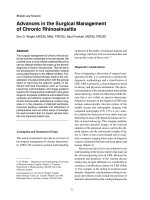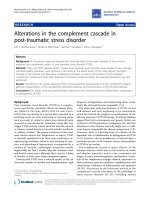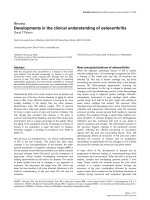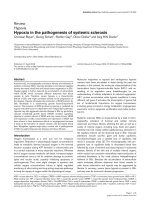Báo cáo y học: "Erythropoietin in the critically ill – is it more than just blood" ppt
Bạn đang xem bản rút gọn của tài liệu. Xem và tải ngay bản đầy đủ của tài liệu tại đây (30.95 KB, 2 trang )
325
EPO = erythropoietin; RBC = red blood cell.
Available online />Recombinant human erythropoietin (EPO) has been in
widespread clinical use for over 15 years. Initially employed
for the treatment of anemia associated chronic renal failure, it
has now been demonstrated to be effective in treating
anemia in a variety of other clinical settings, including HIV,
cancer, surgery, and most recently critical illness [1]. Over
the past several years it has become apparent that EPO has
actions other than ‘just’ stimulating bone marrow to produce
mature erythrocytes. EPO is also a cytokine with important
antiapoptotic activity [2]. In this latter role, EPO has been
demonstrated to confer important tissue protection in
preclinical and some clinical studies [3–6].
In their excellent review in this issue of Critical Care,
Coleman and Brines [7] provide a succinct discussion of the
‘nonhematologic’ actions of EPO in protecting tissues and
raise the intriguing possibility of clinical use of EPO to
‘protect’ tissues in the critically ill. Apoptosis is important in
the pathogenesis of many critical illnesses such as sepsis
and multiorgan failure. Experimental studies have also
suggested that blocking apoptosis may be of benefit.
Therefore, if pharmacologic doses of EPO were administered
to critically ill patients, would the antiapoptotic activity EPO
result in improved clinical outcomes?
Some data bearing on this question are currently available.
Two prospective randomized clinical trials examined the
efficacy of EPO administration in reducing red blood cell
(RBC) transfusion in the critically ill [8,9]. Both studies
demonstrated a significant reduction in the number of RBC
transfusions with EPO administration; however, no clinical
outcome benefits were observed to be associated with this
reduction in RBC transfusion. It is important to note that these
studies were only designed to look at RBC transfusion and
were not powered to look at clinical outcome differences. On
the other hand, even if a clinical outcome benefit were
observed, it would be very difficult to separate nontransfusion-
from transfusion-related effects of EPO in any clinical study.
Any clinical benefit observed could be a result of a higher
hemoglobin level, the avoidance of RBC transfusions, a direct
effect of EPO, or some combination of these factors.
Although the possibility of tissue protective benefit with EPO
administration in the critically ill is clearly of interest, the
difficulties involved in conducting clinical studies to test the
hypothesis should not be underestimated. The studies to
date that suggested a protective role of EPO have been
conducted in clinical settings, such as neurologic injury, in
which the populations studied were well defined and in
which the timing of injury and the initiation of therapy could
be defined [4]. This is clearly not the case in the critically ill
population, in which patients are a heterogeneous group,
there may be multiple insults, and the time from initiation of
‘disease’ to presentation can be highly variable and often
Commentary
Erythropoietin in the critically ill – is it more than just blood?
Howard L Corwin
Professor of Medicine and Anesthesiology, Dartmouth Medical School, Section Chief, Critical Care Medicine, Medical Director, Intensive Care Unit,
Dartmouth-Hitchcock Medical Center, Lebanon, New Hampshire, USA
Corresponding author: Howard L Corwin,
Published online: 6 September 2004 Critical Care 2004, 8:325-326 (DOI 10.1186/cc2949)
This article is online at />© 2004 BioMed Central Ltd
See Review, page 337
Abstract
Erythropoietin (EPO) has been in clinical use for the treatment of anemia for over 15 years. Recently it has
been demonstrated that EPO has actions other than stimulating the bone marrow. It has been suggested
that due to its tissue protecting effect, EPO may be effective in improving outcome in the critically ill.
Keywords apoptosis, erythropoietin, sepsis
326
Critical Care October 2004 Vol 8 No 5 Corwin
difficult to determine. More importantly, the pathophysiology
of tissue injury in the critically ill can be quite complex,
involving many interacting factors [10,11]. The history of
clinical trials in sepsis should stand as an example of the
challenges in performing such studies [12].
The recent appreciation of the importance of the
nonhematologic activities of EPO is providing exciting new
avenues for study. Despite the inherent difficulties in
performing these studies in the critically ill, the potential for
EPO to be of benefit in the critically ill is an important issue. At
a minimum, EPO is clearly effective in reducing the number of
RBC units transfused in patients with the anemia of critical
illness, similar to the effect of EPO in patients with anemia
associated with other clinical conditions. However, it remains
to be seen whether any outcome benefits are associated with
EPO administration, either related to transfusion effects or, in
some patients, a direct effect of EPO.
Competing interests
The author is a consultant and has received research support
from Ortho Biotech Products, LP.
References
1. Henry DH, Bowers P, Romano MT, Provenzano R: Epoetin Alfa:
clinical evolution of a pleiotropic cytokine. Arch Intern Med
2004, 164:262-276.
2. Erbayraktar S, Yilmaz O, Gokmen N, Brines M: Erythropoietin is
a multifactorial tissue-protective cytokine. Curr Hematol Rep
2003, 2:465-470.
3. Silverberg DS, Wexler D, Blum M, Keren G, Sheps D, Leibovitch
E, Brosh D, Laniado S, Schwartz D, Yachnin T, et al.: The use of
subcutaneous erythropoietin intravenous iron for the treat-
ment of the anemia of severe, resistant congestive heart
failure improves cardiac and renal function and functional
cardiac class and markedly reduces hospitalization. J Am Coll
Cardiol 2000, 35:1737-1744.
4. Ehrenreich H, Hasselblatt M, Dembowski C, Cepek L, Lewczuk P,
Stiefel M, Rustenbeck HH, Breiter N, Jacob S, Knerlich F, et al.:
Erythropoietin therapy for acute stroke is both safe and bene-
ficial. Mol Med 2002, 8:495-505.
5. Brines ML, Ghezzi P, Keenan S, Agnello D, de Lanerolle NC,
Cerami C, Itri LM, Cerami A: Erythropoietin crosses the blood
brain barrier to protect against experimental brain injury. Proc
Natl Acad Sci USA 2000, 97:10526-10531.
6. Liu XZ, Xu XM, Hu R, Du C, Zhang SX, McDonald JW, Dong HX,
Wu YJ, Fan GS, Jacquin MF, et al.: Neuronal and glial apoptosis
after traumatic spinal cord injury. J Neurosci 1997, 17:5395-
5406.
7. Coleman T, Brines M: Science review: Recombinant human
erythropoietin in critical illness: a role beyond anemia? Crit
Care 2004, 8:337-341.
8. Corwin HL, Gettinger A, Rodriguez RM, Pearl RG, Gubler KD,
Enny C, Colton T, Corwin MJ: Efficacy of recombinant human
erythropoietin in the critically ill patient: A randomized double
blind placebo controlled trial. Crit Care Med 1999, 27:2346-
2350.
9. Corwin HL, Gettinger A, Pearl RG, Fink MP, Levy MM, Shapiro
MJ, Corwin MJ, Colton T; EPO Critical Care Trials Group: Effi-
cacy of recombinant human erythropoietin in the critically ill
patient: a randomized double blind placebo controlled trial.
JAMA 2002, 288:2827-2835.
10. Hotchkiss RS, Karl IE: The pathophysiology and treatment of
sepsis. N Engl J Med 2003, 348:138-150.
11. Cohen J: The immunopathogenesis of sepsis. Nature 2002,
420:885-891.
12. Nasraway SA: The problems and challenges of immunother-
apy in sepsis. Chest 2003, Suppl:451S-459S.









